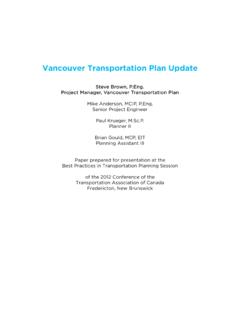Transcription of Precast Options for Bridge Superstructure Design
1 Precast Options for Bridge Superstructure Design John R. Fowler, Canadian Precast /Prestressed Concrete institute Bob Stofko, McCormick Rankin Corporation Paper prepared for presentation at the Bridges Economical and Social Linkages Session of the 2007 Annual Conference of the Transportation Association of Canada Saskatoon, Saskatchewan 1. ABSTRACT. Precast construction offers many Options for Bridge owners and designers: Traditional solutions are I-girders, slab girders and box girders with traditional I-girders being replaced by a new family of more efficient bulb T girders with depths ranging from 1200 to over 2400 mm.
2 Box and trapezoidal girders provide lower span/depth ratios and are more aesthetically pleasing. Each province has their own limitations on the size and weight of Bridge members that can be transported by road. Multi-axle and steerable trailers are available to maximize girder component size. Spliced girder construction can be used when these limits are exceeded; here girder elements are erected on temporary scaffolding, connected together and post-tensioned to achieve spans of 60 to 80 m. Longitudinal post-tensioning through girders for live loading may reducing the number of girder lines.
3 Custom solutions can be explored for large projects where the tooling-up costs can be spread over a large number of similar Precast concrete components. The same thing can apply with new solutions for types of bridges that can be repeated on a variety of sites over a number of years. The fast erection of Precast Bridge components can speed up Bridge construction. Installation in urban areas can occur in off-peak and at night to minimize traffic interruptions. Multiple cranes, barges, temporary bridges, launching trusses can be implemented on difficult sites to help protect the environment.
4 Safe efficient Precast concrete construction with built-in durability will ensure the lowest total cost of ownership for the traveling public. 2. Span Range: 6 to 17 m INTRODUCTION. Span/Depth: 25 30. Bridge designers have a variety of Options Alberta Hollow Slab Girder available when considering the advantages of Precast concrete construction. Superstructure Design is usually based on the following parameters: Roadway width and the provision for sidewalks and/or bicycle lanes Bridge length will be determined by what Width 1206 mm, depth 650 mm is being crossed, hydraulic opening Void diameter 450 mm requirements and topography Span Range 16 to 20 m The cost of the Bridge relative to the Box Girders approaches can sometimes establish the best abutment location.
5 Span lengths will be determined by: Available pier locations Vertical clearance requirements and flexibility in road profile Safety standards Offset requirements from substructure elements to adjacent lanes Relative cost of the Superstructure and Width: 1220. the supporting piers Depths: 685, 750, 838, 991, 1067, 1300 mm Span Range: 15 to 32 m Structure depth will be determined by span Span/Depth: 25 - 35. length. Bridge skew will be determined by Bridge Slab Bridge Options alignment relative to what is being crossed.
6 TRADITIONAL SECTIONS. Slab Bridge Sections Voided Slab Girders Adjacent girder bridges are slender and require no deck forming. Width: 1220. Depths: 305, 381, 457, 510, 533, 635 mm 3. Spaced girder bridges require fewer girders and can be shallower than I-girder bridges. CPCI Bridge Girder Sections Conventional rebar reinforcement Channel and Double Stemmed Bridge Sections Depths: 900, 1200, 1400, 1600, 1900, 2300 Limited Use: These sections can be Span Range: 20 to 45 m designed using existing double tee forms Span/Depth: 15 20 and may be suitable for secondary road bridges.
7 4. Girder Diaphragms NU Girders [9]. NU Girders are used in Western Canada. Web width is 180 mm when post-tensioning ducts are cast in the web for continuity and splicing sections together. Bulb-Tee Bridge half diaphragms can be integrally cast at the Precast plant and joined together at the site by welding or post-tensioning. NEBT Girders [10]. NEBT Girders are used in the Maritimes and Quebec. These are heavier sections Bulb-Tee diaphragms can also be structural with more cover to protect the reinforcement steel X-bracing left exposed or cast into the against salt exposure.
8 Finished diaphragm. Bulb-Tee Manufacturing NEW BULB-TEE Bridge GIRDER. SECTIONS. I-girders are being replaced by a new family of more efficient bulb T girders with depths ranging from 1200 to over 2400 mm. Welded wire reinforcement is made to order and bent to size for individual projects. 5. Stringer Bridge vs. Slab Bridge Behaviour [1]. Structural behavior of slab and stringer bridges Slab/Slab Bridge Connections [1]. Horizontal ties joining slab Bridge elements Continuity A semi-continuous Design approach is typically adopted to avoid expansion joints at piers.
9 Girders are erected as simple . spans and are made continuous by casting the reinforced concrete deck slab and diaphragms. Welded Wire Reinforcement [12]. The girders act as simple spans under self Welded wire reinforcement is a cost effective way to place mild reinforcing steel weight and the wet slab load. Under superimposed dead loads and live load, in Precast girders. Cold drawn wires are girders are continuous, hence the term welded together in a square or rectangular semi-continuous. In addition to eliminating grid.
10 While material costs may be higher, expensive and failure prone joints, this installation costs can be substantially lower. approach also is more structurally efficient GIRDER Design AND MODELING and economic than one that uses simple spans. Precast Bridge girders are designed for shipping and handling stresses as well as Full continuity can be achieved through for in-service loads. post-tensioning (see Section 7 below). 6. Integral Abutments Integral abutment designs have become very common in the last 10 years for short to medium span structures (total length of 150m to 200m).



